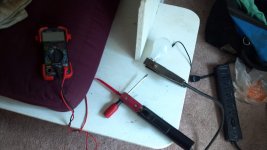Mark @ Everlast
Advertiser
I'd be interested to know whaat the ocv is coming out of the machine on dc and ac...bet that will tell us a lot more about the welder than anything.
I'd be interested to know whaat the ocv is coming out of the machine on dc and ac...bet that will tell us a lot more about the welder than anything.
Maybe rig an ordinary 110v light bulb across the output to make a dummy load, then measure the ac volts?

If it is a newer welder, it could have a voltage reduction device that reduces the OCV. But I highly doubt it.joshuabardwell said:Another interesting fact that may be relevant is that a couple times, when I turned the welder on in preparation for running a test, it would show just 1 volt AC, until I touched the leads to the light bulb, after which it would jump to the above readings and not return to 1 volt AC until I turned the welder off and back on again.
If it is a newer welder, it could have a voltage reduction device that reduces the OCV. But I highly doubt it.
joshuabardwell said:I'm honestly not even sure why there is so much AC voltage on the DC output at all. Shouldn't the diodes be preventing this?